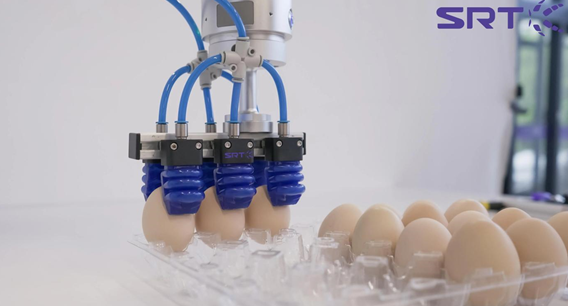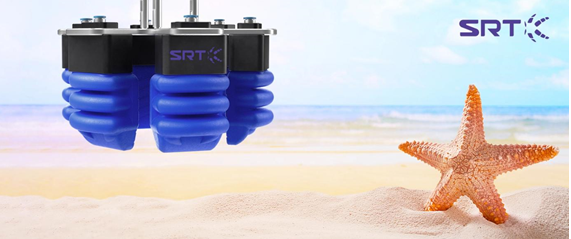1. The Hierarchy of Flexibility: Defining the Trio
Imagine a world where machines don’t just follow rigid commands but “adapt”—bending, conforming, and interacting gently with their surroundings. This is the realm of soft robotics, a field reshaping traditional notions of what robots can be. At its core lies the principle of compliance: using materials like silicone, pneumatic elastomers, or shape-memory polymers to create systems that mimic biological flexibility.
A soft robot is the holistic embodiment of this philosophy—a machine whose structure, movement, and even “personality” emerge from soft materials. Unlike industrial robots with metal joints and fixed trajectories, think of it as a robotic octopus arm navigating coral reefs or a worm-like device inching through earthquake debris.
Nestled within this ecosystem is the soft gripper, a specialized tool designed for manipulation. Picture a robotic hand that cradles a raw egg without cracking it, or lifts a jagged rock without slipping—its “fingers” deforming to the object’s contours, much like human fingertips adjusting pressure intuitively. Soft grippers are not just components; they’re the interface where soft robotics’ magic meets practicality, bridging the gap between gentle touch and functional strength.
In essence: soft robotics is the discipline, soft robots are the systems, and soft grippers are their versatile appendages—each reliant on flexibility, but operating at different scales of complexity.
2. Soft Grippers: The Unsung Heroes of Gentle Precision
What makes a soft gripper tick? Unlike rigid claws that rely on force and exact positioning, these grippers use adaptive compliance. Consider a pneumatic gripper with hollow silicone fingers: when air is suctioned out, the fingers collapse around an object, conforming to its shape like a rubber mold. No need for precise pre-programmed motions—contact itself guides the grip, much like how a child’s hand wraps around a seashell of unknown shape.
This adaptability solves a critical problem in robotics: the “uncertainty challenge.” Traditional robots struggle with objects that vary in texture (a wet strawberry vs. a dry tennis ball) or geometry (a curved glass vase vs. a flat smartphone). Soft grippers, however, treat every object as a unique puzzle, using their malleable structure to create a custom fit. For example, a soft gripper inspired by octopus suckers might use micro-structured surfaces to adhere to both smooth and porous items, eliminating the need for multiple tool changes in manufacturing lines.
Safety is another game-changer. In a warehouse where human workers and robots share space, a soft gripper reduces collision risks. Unlike metal claws that could cause injury, a silicone-based gripper acts like a padded hand—softening impacts and even “apologizing” with a gentle rebound if it bumps into someone.
3. Soft Robots: Redefining Robotic Possibilities
Soft robots excel where rigidity fails. Let’s explore their groundbreaking applications:
In minimally invasive surgery, rigid robotic arms face a paradox: they need to be precise yet gentle in the body’s soft, slippery environment. Enter soft surgical robots—imagine a snake-like endoscope with a flexible tip that navigates the intestinal tract without scraping tissue, or a gripper that sutures delicate blood vessels using controlled elasticity, not brute force.
For rehabilitation, soft exoskeletons are rewriting mobility. Unlike bulky metal exoskeletons, their soft counterparts use textile-based actuators that conform to the body, assisting walking with natural gait patterns. A stroke patient wearing such an exoskeleton might feel less like they’re strapped to a machine and more like they’re gaining an extra layer of muscular support.
E-commerce fulfillment centers are a prime example. With thousands of oddly shaped products (think plush toys, glassware, and irregularly packaged goods), traditional grippers require constant reprogramming. Soft grippers, by contrast, handle this chaos effortlessly—one gripper might pick up a shampoo bottle with a firm grasp and a loaf of bread with a gentle squeeze, all without software updates.
In automotive manufacturing, soft robots are revolutionizing assembly. A soft robotic arm could install fragile car interior components—aligning a dashboard screen with millimeter precision by “feeling” its way into place, rather than relying on rigid positional data.
Underwater, soft robots mimic marine life. A robotic jellyfish propels itself through ocean currents using pulsating silicone “bells,” collecting microplastics without harming plankton. On land, a soft-bodied robot inspired by earthworms could navigate collapsed buildings, squeezing through cracks to locate survivors—its lack of rigid joints making it immune to jams or structural damage.
4. The Future of Soft Robotics: Beyond the Basics
Researchers are developing materials that go beyond mere flexibility. Self-sensing elastomers can “feel” pressure, strain, and even temperature, allowing soft grippers to adjust their grip in real time—imagine a robotic hand that knows exactly how hard to hold a melting ice cream cone. Biomimetic composites, inspired by octopus skin, might change color or texture to blend into environments, useful for stealthy exploration or adaptive camouflage in search missions.
Pairing soft robotics with artificial intelligence creates systems that learn from experience. A soft gripper equipped with machine learning might analyze thousands of grasping attempts, improving its technique over time—much like a human learning to juggle. In the future, soft robots could anticipate user needs: a kitchen assistant that knows how tightly to hold a coffee mug based on whether it’s full or empty, or A retail robot that modifies its grasp according to a customer’s ideal handshake tension.
As soft robots grow more human-centric in their interactions, issues surrounding safety and autonomy emerge. How do we ensure a soft surgical robot knows when to stop if unexpected tissue resistance is felt? Innovators are developing “ethical sensors” that prioritize human safety over task completion, adding a layer of fail-safes to prevent unintended harm.
Accessibility is another focus.Affordable 3D-printed soft grippers have the potential to empower DIY hobbyists and developing regions, fostering the democratization of robotic technology.A farmer in a rural area might print a soft gripper to harvest delicate fruits, bypassing the need for expensive rigid machinery.
No revolution is without hurdles. Soft robots face limitations in load capacity (a soft gripper can’t lift a car—yet) and durability (repeated bending may degrade materials over time). Researchers are tackling these with hybrid designs—combining soft components for adaptability and rigid elements for strength, like a robot with soft fingers but a sturdy wrist.
Environmental sustainability is also critical. As soft robotics expands, ensuring materials are recyclable or biodegradable (think seaweed-based elastomers for ocean robots) will be key to preventing ecological harm.
Conclusion
Soft grippers, soft robots, and soft robotics are not just technological upgrades—they’re a paradigm shift. By embracing flexibility, these innovations bridge the gap between machine precision and human intuition, creating tools that don’t just perform tasks but adapt to life’s unpredictability. From healing the human body to exploring alien landscapes, their journey is just beginning. As materials grow smarter, AI more intuitive, and designs more inclusive, the era of “gentle machines” is upon us—a future where robots don’t just coexist with us, but collaborate with us, one soft grip at a time.




































